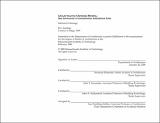Catalan vaulting in advanced material : new approaches to contemporary compressive form
Author(s)
Ramage, Michael H. (Michael Hector)
DownloadFull printable version (45.66Mb)
Other Contributors
Massachusetts Institute of Technology. Dept. of Architecture.
Advisor
Fernando Domeyko, John E. Fernandez and John A. Ochsendorf.
Terms of use
Metadata
Show full item recordAbstract
The translation of traditional building methods to modern construction techniques offers unexplored opportunities for material and form in architecture. Recent innovations in cellular ceramics married with traditional timbrel vaulting suggest a new approach to compressive form in structural masonry spans. Research into the history and construction of timbrel vaults and the material properties of cellular ceramic masonry shows that they are well-suited to one another. Building timbrel vaults with aerated autoclaved concrete (AAC) brings to architectural practice a new family of economically viable, expressive configurations of structural spans in masonry. The Catalan masonry technique, also referred to as timbrel or Guastavino vaulting, allows thin structural spans to be built without the use of supporting formwork. Once widely used in American construction, the technique is now little-known. This thesis documents the recent construction of two 11.3m (37') domes in England and structural research into building timbrel vaults with AAC tile. An artist's studio designed based on the information gained demonstrates the renewed feasibility of building expressive masonry structures. The techniques used to design and build structural masonry spans show that merging modern materials with traditional craft capitalizes on the significant strengths of each. These new buildings demonstrate the economic efficiency and formal viability of timbrel vaulting in contemporary architecture.
Description
Thesis (M. Arch.)--Massachusetts Institute of Technology, Dept. of Architecture, 2006. This electronic version was submitted by the student author. The certified thesis is available in the Institute Archives and Special Collections. Includes bibliographical references (p. 55-57).
Date issued
2006Department
Massachusetts Institute of Technology. Department of ArchitecturePublisher
Massachusetts Institute of Technology
Keywords
Architecture.